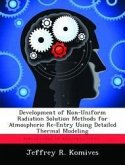Current satellite orbit propagation techniques employ a solar radiation pressure model that makes simplifying assumptions concerning the satellite and its orbital geometry. The time-intensive nature of orbit determination computations justifies the use of simplifying assumptions, but at the expense of increased accuracy in orbit predictions. Solar radiation pressure, a non-gravitational perturbation, significantly affects satellite motion at high altitudes. The model currently in use by the Air Force for orbit determination includes the following assumptions: a constant cross-sectional area projected to the Sun, cylindrical Earth shadow for eclipse, and specular reflection. In reality, the satellite`s cross-sectional area with respect to the Sun constantly changes, the Earth's shadow is conical, and reflection is both specular and diffuse. Additionally, the solar flux received at the Earth can be either assumed constant or variably dependent on the distance from the Sun. These four higher order effects may be modeled in lieu of the simplifying assumptions to obtain greater accuracy in orbit predictions. Comparison of a baseline that embodies the Air Force's current solar radiation pressure model, and a truth model that simulates the four solar radiation pressure effects will be presented. The most significant effect relating to solar radiation pressure is the changing cross-sectional area of the satellite projected to the Sun. The other higher order effects may be satisfactorily modeled via the baseline.








